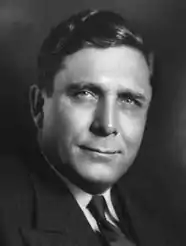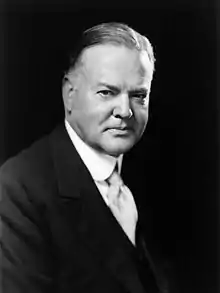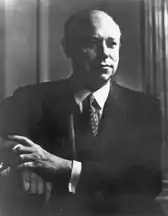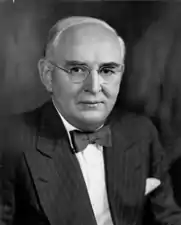1940 Republican National Convention
The 1940 Republican National Convention was held in Philadelphia, Pennsylvania, from June 24 to June 28, 1940. It nominated Wendell Willkie of New York for president and Senator Charles McNary of Oregon for vice president.
| 1940 presidential election | |
 .jpg.webp) Nominees Willkie and McNary | |
| Convention | |
|---|---|
| Date(s) | June 24–28, 1940 |
| City | Philadelphia, Pennsylvania |
| Venue | Philadelphia Convention Hall |
| Candidates | |
| Presidential nominee | Wendell Willkie of New York |
| Vice presidential nominee | Charles L. McNary of Oregon |
| Ballots | 6 |
The contest for the 1940 Republican presidential nomination was wide-open. Front-runners included Senator Arthur H. Vandenberg of Michigan, Senator Robert Taft of Ohio and Manhattan District Attorney Thomas E. Dewey.
Presidential candidates
- Newspaper editor and owner Frank Gannett of New York
- Governor Arthur James of Pennsylvania
- House Minority Leader Joseph W. Martin of Massachusetts



Former President
Herbert Hoover
from California.jpg.webp)



The race
In the months leading up to the opening of the 1940 Republican National Convention, the three leading candidates for the GOP nomination were considered to be Senators Robert A. Taft of Ohio and Arthur Vandenberg of Michigan, and District Attorney Thomas E. Dewey of New York. Taft was the leader of the GOP's conservative, non-interventionist wing, and his main strength was in his native Midwest and parts of the South. Vandenberg, the senior Republican in the Senate, was the "favorite son" candidate of the Michigan delegation and was considered a possible compromise candidate. Dewey, the District Attorney for Manhattan, had risen to national fame as the "Gangbuster" prosecutor who had sent numerous infamous mafia figures to prison, most notably "Lucky" Luciano, the organized-crime boss of New York City.
All three men had campaigned vigorously during the primary season, but only 300 of the 1,000 convention delegates had been pledged to a candidate by the time the convention opened. Moreover, each of these candidates had weaknesses that could be exploited. Taft's outspoken non-interventionism and opposition to any American involvement in the European war convinced many Republican leaders that he could not win a general election, particularly as the French Third Republic fell to Nazi Germany in May 1940 and Germany threatened the United Kingdom. Dewey's relative youth - he was only 38 in 1940 - and lack of any foreign-policy experience caused his candidacy to weaken as the Nazi military emerged as a fearsome threat. In 1940 Vandenberg was also a non-interventionist (he changed his foreign-policy stance during World War II) and his lackadaisical, lethargic campaign never caught the voter's attention. This left an opening for a dark horse candidate to emerge.
Willkie emerges as a dark horse
.jpg.webp)
A Wall Street-based industrialist named Wendell Willkie, who had never before run for public office, emerged as the unlikely nominee. Willkie, a former Democrat who had been a pro-Roosevelt delegate at the 1932 Democratic National Convention, was considered an improbable choice. Willkie had first come to public attention as an articulate critic of Roosevelt's attempt to break up electrical power monopolies. Willkie was the CEO of the Commonwealth and Southern power company, and he opposed the federal government's attempts to compete with private enterprise, claiming that the government had unfair advantages over private companies. Willkie did not dismiss all of Roosevelt's social welfare programs, and in fact supported those he believed could do better than free enterprise.
Furthermore, unlike the leading Republican candidates, Willkie was a forceful and outspoken advocate of aid to the Allies, especially the United Kingdom. His support of giving all aid to the British "short of declaring war" won him the support of many Republicans on the East Coast, who disagreed with their party's isolationist leaders in Congress. Willkie's persuasive arguments impressed these Republicans, who believed that he would be an attractive presidential candidate. Many of the leading press barons of the era, such as Ogden Reid of the New York Herald Tribune, Roy Howard of the Scripps-Howard newspaper chain and John and Gardner Cowles, Jr., publishers of the Minneapolis Star and the Minneapolis Tribune, as well as the Des Moines Register and Look magazine, supported Willkie in their newspapers and magazines. Even so, Willkie remained a long-shot candidate; the May 8 Gallup Poll showed Dewey at 67% support among Republicans, followed by Vandenberg and Taft, with Willkie at only 3%.
The Nazi Army's rapid blitzkrieg into France in May 1940 shook American public opinion, even as Taft was telling a Kansas audience that America must concentrate on domestic issues to prevent Roosevelt from using the international crisis to extend socialism at home. Both Dewey and Vandenberg also continued to oppose any aid to the United Kingdom that might lead to war with Germany. Nevertheless, sympathy for the embattled British was mounting daily, and this aided Willkie's candidacy. By mid-June, little over one week before the Republican Convention opened, the Gallup poll reported that Willkie had moved into second place with 17%, and that Dewey was slipping. Fueled by his favorable media attention, Willkie's pro-British statements won over many of the delegates. As the delegates were arriving in Philadelphia, Gallup reported that Willkie had surged to 29%, Dewey had slipped 5 more points to 47%, and Taft, Vandenberg and former President Herbert Hoover trailed at 8%, 8%, and 6% respectively.
Hundreds of thousands, perhaps as many as one million, telegrams urging support for Willkie poured in, many from "Willkie Clubs" that had sprung up across the country. Millions more signed petitions circulating everywhere.
Balloting
At the 1940 Republican National Convention itself, keynote speaker Harold Stassen, the Governor of Minnesota, announced his support for Willkie and became his official floor manager. Hundreds of vocal Willkie supporters packed the upper galleries of the convention hall. Willkie's amateur status and his fresh face appealed to delegates as well as voters. The delegations were selected not by primaries but by party leaders in each state, and they had a keen sense of the fast-changing pulse of public opinion. Gallup found the same thing in polling data not reported until after the convention: Willkie had moved ahead among Republican voters by 44% to only 29% for the collapsing Dewey.
As the pro-Willkie galleries repeatedly chanted "We Want Willkie!", the delegates on the convention floor began their vote. Dewey led on the first ballot but steadily lost strength thereafter. Both Taft and Willkie gained in strength on each ballot, and by the fourth ballot it was obvious that either Willkie or Taft would be the nominee. The key moments came when the delegations of large states such as Michigan, Pennsylvania, and New York left Dewey and Vandenberg and switched to Willkie, giving him the victory on the sixth ballot. The voting went like this:
| Presidential Balloting, RNC 1940[1] | |||||||
|---|---|---|---|---|---|---|---|
| Ballot: | 1 | 2 | 3 | 4 | 5 | 6 before shifts | 6 after shifts |
| Wendell L. Willkie | 105 (10.5%) | 171 (17.1%) | 259 (25.9%) | 306 (30.6%) | 429 (42.9%) | 655 (65.5%) | 998 (99.8%) |
| Ohio Senator Robert A. Taft | 189 (18.9%) | 203 (20.3%) | 212 (21.2%) | 254 (25.4%) | 377 (37.7%) | 318 (31.8%) | -- |
| Thomas E. Dewey | 360 (36.0%) | 338 (33.8%) | 315 (31.5%) | 250 (25.0%) | 57 (5.7%) | 11 (1.1%) | -- |
| Michigan Senator Arthur Vandenberg | 76 | 73 | 72 | 61 | 42 | -- | -- |
| Pennsylvania Governor Arthur H. James | 74 | 66 | 59 | 56 | 59 | -- | -- |
| Massachusetts Rep. Joseph W. Martin | 44 | 26 | -- | -- | -- | -- | -- |
| Hanford MacNider | 34 | 34 | 28 | 26 | 4 | -- | -- |
| Frank E. Gannett | 33 | 30 | 11 | 4 | 1 | 1 | -- |
| Former President Herbert Hoover | 17 | 21 | 32 | 31 | 20 | 10 | -- |
| New Hampshire Senator Styles Bridges | 28 | 9 | 1 | 1 | -- | -- | -- |
| Scattering / Blank | 40 | 29 | 11 | 11 | 11 | 5 | 2 |
"On the first ballot, Dewey was ahead followed by Taft and Willkie. Thereafter, Dewey steadily lost strength while Taft and Willkie picked up votes. On the fourth ballot Willkie was ahead but short of the 501 votes needed for nomination. On the sixth roll call — 1 a.m. Friday — Willkie finally went over the top."[2] Willkie's nomination is still considered by most historians to have been one of the most dramatic moments in any political convention.
Willkie also made history too by his personal appearance at the 1940 convention. "WILLKIE BREAKS PARTY TRADITION BY PERSONAL APPEARANCE LIKE ROOSEVELT'S IN '32", The New York Times' headline told its readers. "CROWD GOES WILD GREETING NOMINEE" and "CHEERS MARK HIS EVERY WORD" in The New York Times' headlines convey something of the convention's mood in 1940 with Willkie's appearance. "As your nominee," Willkie told the convention in his brief appearance, "I expect to conduct a crusading, vigorous, fighting campaign."
Willkie's acceptance speech
Willkie delivered his acceptance speech from the podium at the convention hall, something that never happened at a Republican convention before.[3] It was broadcast on a local television station,[4] also a first.
A couple of months later, Willkie again accepted the nomination in a kick-off speech at Calloway Park in his hometown of Elwood, Indiana.
Vice Presidential nomination
Willkie had given little thought to the vice-presidential nominee. He left the decision to the convention chairman, Representative Joe Martin (R-Massachusetts), the House Minority Leader. Martin suggested Senate Minority Leader Charles L. McNary of Oregon. Though McNary had spearheaded a "Stop Willkie" campaign late in the balloting, Willkie agreed, and McNary was selected on the first ballot:
| Charles L. McNary | 848 |
|---|---|
| Dewey Short | 108 |
| Styles Bridges | 2 |
Television coverage
The 1940 Republican Convention was the first national party convention shown on live television, and was seen in three cities on "pioneer stations". It was broadcast in New York by NBC on W2XBS (now WNBC), in Philadelphia by W2XE (now KYW-TV), and in Schenectady on W2XB (now WRGB). The convention was also shown on television screens in the exhibition hall of the Commercial Museum of Philadelphia, next door to the Convention Hall, for "overflow" crowds. Local newspapers predicted that two thousand people would view the convention from the museum, and estimates range as high as 6,000 total television viewers in all three cities.[5]
Bomb discoveries
During the convention, two dynamite bombs were discovered outside of the hall; a total of seven bombs were discovered in the greater Philadelphia area during the convention. The discoveries of the bombs were inadvertently released to the public by an emotional New York City police commissioner Lewis J. Valentine while discussing the New York World's Fair bombing that killed two police officers.[6]
See also
- History of the United States Republican Party
- List of Republican National Conventions
- U.S. presidential nomination convention
- 1940 Republican Party presidential primaries
- 1940 United States presidential election
- 1940 Democratic National Convention
- The Golden Age, historical novel by Gore Vidal, which charges corruption in the management of the convention.
References
- Richard C. Bain and Judith H. Parris, Convention Decisions and Voting Records (1973), pp. 254–256
- 1940 GOP Convention Archived January 1, 2007, at the Wayback Machine
- https://www.amazon.com/Five-Days-Philadelphia-Political-Convention/dp/1586484508/ref=sr_1_3?dchild=1&keywords=1940+republican+convention&qid=1597686444&sr=8-3
- "Television, FDR and the 1940 Presidential Conventions". fdr.blogs.archives.gov. Franklin D. Roosevelt Presidential Library and Museum/National Archives. 28 July 2020. Retrieved 10 August 2020.
- "1940 Republican Convention". www.earlytelevision.org. Retrieved 2 April 2018.
- "Says Bombs found near G.O.P's Hall". Reading Eagle. July 11, 1940.
Further reading
| External video | |
|---|---|
- Charles Peters (2005), Five Days in Philadelphia: The Amazing "We Want Willkie" Convention of 1940 and How It Freed FDR to Save the Western World, New York: Public Affairs.
External links
- Republican Party platform of 1940 at The American Presidency Project
- Willkie acceptance speech at The American Presidency Project
- Video of 1940 Republican National Convention
| Preceded by 1936 Cleveland, Ohio |
Republican National Conventions | Succeeded by 1944 Chicago, Illinois |